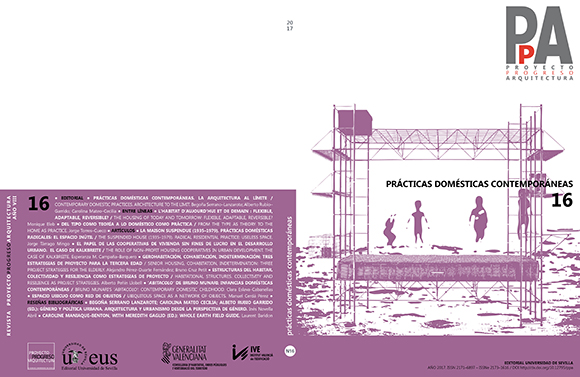EL PAPEL DE LAS COOPERATIVAS DE VIVIENDA SIN FINES DE LUCRO EN EL DESARROLLO URBANO. EL CASO DE KALKBREITE / THE ROLE OF NON-PROFIT HOUSING COOPERATIVES IN URBAN DEVELOPMENT. THE CASE OF KALKBREITE
DOI:
https://doi.org/10.12795/ppa2017.i16.04Palabras clave:
cooperativa, cesión de uso, Kalkbreite, Zúrich, Müller Sigrist, vivienda colectiva urbana / cooperative, cession of use, Zurich, collective urban housingResumen
RESUMEN El presente artículo comienza analizando la trayectoria y el funcionamiento de las cooperativas de vivienda en cesión de uso en el marco geográfico suizo. Después, particulariza en el caso de la genossenschaft Kalkbreite, una experiencia reciente localizada en el tradicional distrito obrero de Zúrich. Allí una renovada atención sobre la promoción inmobiliaria sin fines de lucro ha producido ejemplos de notable interés arquitectónico a la vez que novedosos en el ámbito de la participación y la gestión del cooperativismo. Mediante un análisis transversal –político, económico y socioespacial– del caso de estudio, se deducen sus procesos proyectuales y sus consecuencias en el diseño urbano y arquitectónico. Estos procesos derivan del entendimiento de la vivienda no como un producto sino como un proceso que fortalece a las comunidades urbanas emergentes en su papel de agentes de un nuevo modelo de desarrollo de ciudad.
SUMMARY The article begins by analyzing the evolution and dynamics of cession of use housing cooperatives in the Swiss context. Following this, it focuses on the case study of the genossenschaft Kalkbreite, a recent experience located within Zurich’s traditional workers district. There, a renewed approach to non-profit real-estate development has produced examples of notable architectural interest that also offer an original take regarding the realm of participation and cooperative management. A cross-sectional –political, economical and social-spatial– analysis of the case study has revealed its design process as well as the consequences it has at an urban and architectural level. These processes derive from understanding housing not as a product but, instead, as a process that strengthens emerging urban communities in their role as agents in a new model of urban development.
KEYWORDS cooperative; cession of use; Kalkbreite; Zurich; Müller Sigrist; collective urban housing
Descargas
Citas
BLUNDELL JONES, Peter; PETRESCU, Doina; TILL, Jeremy, eds. Architecture and participation. Londres-Nueva York: Spon Press, 2005.
CAMERON, Jane; THOROGOOD, James; WOOD, Dominic, eds. Profiles of a movement: Co-operative housing around the world. CECODHAS Housing Europe-ICA Housing, 2012.
Charta der gemeinnützigen Wohnbauträger in der Schweiz [consulta: 26-09-2016]. Disponible en: http://www.wbg-schweiz.ch/wohnbaugenossenschaften_schweiz.html
Construction de logements: La troisième voie. Wohnen Schweiz-Association des Coopératives, 2013.
FENTON, Joseph. “Hybrid Buildings”. En: Pamphlet Architecture. Nueva York, Princeton Architectural Press, 1985, nº11.
FRANK, Frédéric. “The resurgence of the large form”. En: RUIZ. CABRERO, Gabriel; MARTÍN, Sergio; PAJARES, Iván, eds. Casas en Suiza. Madrid: Mairea, 2012.
Genossenschaft Kalkbreite. Projektdokumentation 2014 [consulta: 30-03-2017]. Disponible en: https://www.kalkbreite.net/projekt/bauprojekt/20140923_Kalkbreite-Projektdokumentation_2014_web.pdf
Habiter en coopérative. Les logements des coopératives d’habitation et leurs occupants vus à travers le prisme des recensements de la population de 1970 à 2000. BWO Statistik-Info (ZH) n° 20/2004. Resumé en Français.
HARVEY, David. Ciudades rebeldes. Del derecho a la ciudad a la revolución urbana. Madrid: Akal, 2013.
HUGENTOBLER, Margrit; HOFER, Andreas; SIMMENDINGER, Pia, eds. More than housing. Cooperative planning–A case study in Zürich. Basilea: Birkhäuser, 2016.
LAESSLÉ, Melaine. Les coopératives d’habitation comme alternative au marché immobilier? Valeur d’usage et valeur d’échange du logement. Chavannes-Lausanne: IDHEAP, 2012.
LEFEBVRE, Henri. Le droit à la ville. París: Anthropos, 1968.
MONTEYS, Xavier et al. ¿Y si las piezas de una vivienda están situadas en un local discontinuo? En: Quaderns d’arquitectura i urbanisme. Barcelona, COAC, 2007, nº 253, pp. 62-73. ISSN 1886-1989
OSTROM, Elinor. El gobierno de los bienes comunes. La evolución de las instituciones de acción colectiva. México: Fondo de Cultura Económica, 2011. (2ª Ed.)
REGUSCI, Nicola; BUSTOS, Xavier, eds. Import Zurich: Cooperative housing, new ways of inhabiting. Catálogo de la exposición. Barcelona: DPR-Barcelona, 2015.
SCHINDLER, Susanne. Housing and the Cooperative Commonwealth. En Places Journal [en línea]. Octubre 2014 [consulta: 26-09-2016]. Disponible en: https://placesjournal.org/article/housing-and-the-cooperative-commonwealth/
SENNETT, Richard. El declive del hombre público. Barcelona: Anagrama, 2011. (Edición original de 1977)
“Spielräume für vielfalt. Jorg Himmelreich im Gespräch mit Pascal Müller von Müller Sigrist Architekten”. En: Architese. International thematic review for architecture. Zúrich, Febrero 2014, pp.48-53.
TURNER, John F. C. Vivienda, todo el poder para los usuarios. Madrid: Blume, 1977.
United Nations Development Programme. Human Development Report 2015 [consulta: 26-09-2016]. Disponible en: http://hdr.undp.org/en/countries/profiles/CHE.
Wohnbauförderungsreglement, Junio 2011. Reglamento de Vivienda Subvencionada del Cantón de Zúrich.
WERCZBERGER, Elia. Home ownership and rental control in Switzerland. En: Housing Studies. Londres: Taylor & Francis, 1997, vol.12, nº3, pp. 337–353. ISSN 0267-3037. ISSN-e 1466-1810. DOI: http://dx.doi.org/10.1080/02673039708720900
WEZEMAEL, Joris van. Managing privatised housing. The Swiss case: Causes and impacts of property rights transfers on housing management and maintenance. Working Paper presentado al ENHR Conference Housing in an expanded Europe, 2–7 Julio, Ljubljana, 2006.
Descargas
Publicado
Cómo citar
Número
Sección
Licencia
Las ediciones impresa y electrónica de esta Revista son editadas por el Secretariado de Publicaciones de la Universidad de Sevilla, siendo necesario citar la procedencia en cualquier reproducción parcial o total.
Salvo indicación contraria, todos los contenidos de la edición electrónica se distribuyen bajo una licencia de uso y distribución “Creative Commons Atribución-NoComercial-SinDerivar 4.0 Internacional” ![]() . Puede consultar desde aquí la versión informativa y el texto legal de la licencia. Esta circunstancia ha de hacerse constar expresamente de esta forma cuando sea necesario.
. Puede consultar desde aquí la versión informativa y el texto legal de la licencia. Esta circunstancia ha de hacerse constar expresamente de esta forma cuando sea necesario.
Los autores/as que publiquen en esta revista aceptan las siguientes condiciones:
- Los autores/as conservan los derechos de autor y ceden a la revista el derecho de la primera publicación, con el trabajo registrado con la licencia de atribución de Creative Commons, que permite a terceros utilizar lo publicado siempre que mencionen la autoría del trabajo y a la primera publicación en esta revista.
- Los autores/as pueden realizar otros acuerdos contractuales independientes y adicionales para la distribución no exclusiva de la versión del artículo publicado en esta revista (p. ej., incluirlo en un repositorio institucional o publicarlo en un libro) siempre que indiquen claramente que el trabajo se publicó por primera vez en esta revista.
- Se permite y recomienda a los autores/as a publicar su trabajo en Internet (por ejemplo en páginas institucionales o personales) antes y durante el proceso de revisión y publicación, ya que puede conducir a intercambios productivos y a una mayor y más rápida difusión del trabajo publicado (vea The Effect of Open Access).









